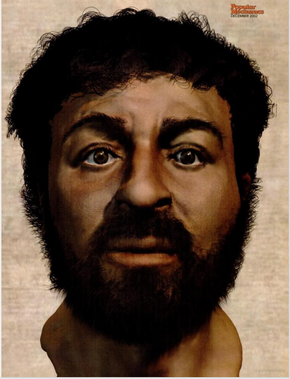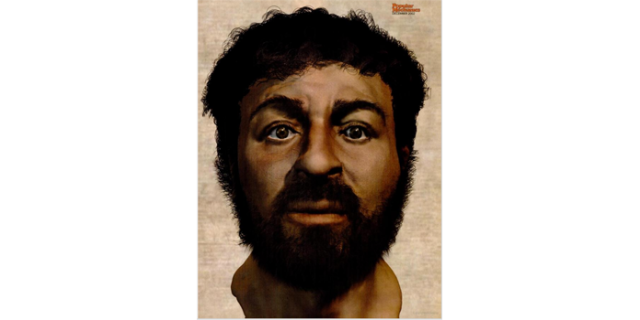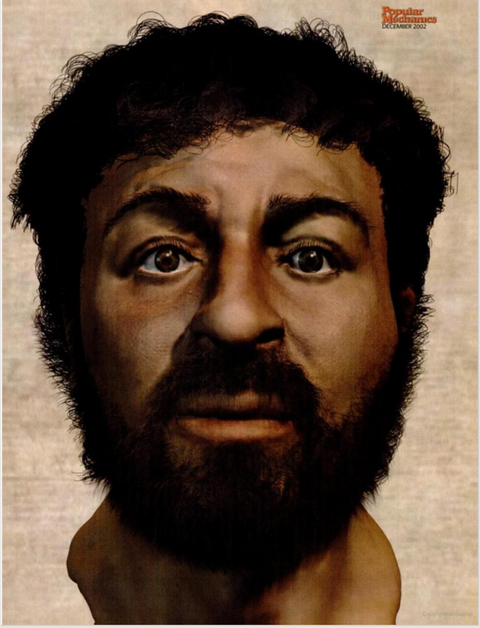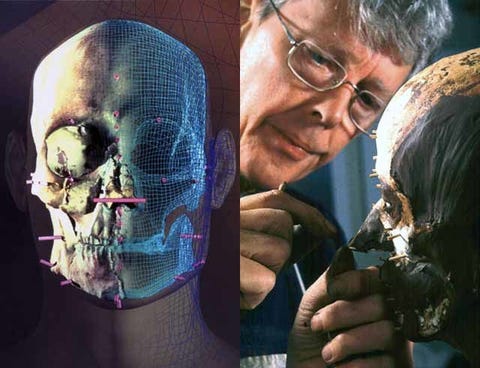Científicos británicos aseguran que Jesús de Nazaret era negro
Son las conclusiones de una investigación realizada mediante antropología forense.
Richard Neave, científico de la Universidad de Manchester, ha pasado una buena parte de su tiempo tratando de reconstruir el rostro de Jesús de Nazaret mediante la antropología forense, una de las subdisciplinas de la antropología física. No es la primera vez que el catedrático realiza un trabajo de este tipo, anteriormente había reconstruido la cara de otras figuras históricas muy populares, como Filipo II de Macedonia (padre de Alejandro Magno) y el Rey Midas.
Para realizar una imagen de Jesús más adaptada a la realidad, el científico contó con tres cráneos del siglo I bien conservados que habían sido hallados en Israel. A partir de ellos, Neave utilizó la tomografía computarizada para intentar obtener hasta el más mínimo detalle.
Estamos acostumbrados a ver representaciones de Jesús de Nazaret que le muestran con melena castaña, tez blanca, ojos claros y barba. Pero la ciencia ahora pone en duda ese aspecto tan caucásico y afirma que su color era negro, tenía una nariz más grande y además, un aspecto mucho más corpulento.
Según explican en Popular Mechanics, los científicos creen que esta recreación de Jesús podría ser la más exacta que se ha realizado hasta la fecha. Según Alison Galloway, profesor de antropología en la Universidad de California "probablemente sea más fiel a la realidad que el trabajo de muchos grandes maestros de la pintura"
Richard Neave, científico de la Universidad de Manchester, ha pasado una buena parte de su tiempo tratando de reconstruir el rostro de Jesús de Nazaret mediante la antropología forense, una de las subdisciplinas de la antropología física. No es la primera vez que el catedrático realiza un trabajo de este tipo, anteriormente había reconstruido la cara de otras figuras históricas muy populares, como Filipo II de Macedonia (padre de Alejandro Magno) y el Rey Midas.
Para realizar una imagen de Jesús más adaptada a la realidad, el científico contó con tres cráneos del siglo I bien conservados que habían sido hallados en Israel. A partir de ellos, Neave utilizó la tomografía computarizada para intentar obtener hasta el más mínimo detalle.
Estamos acostumbrados a ver representaciones de Jesús de Nazaret que le muestran con melena castaña, tez blanca, ojos claros y barba. Pero la ciencia ahora pone en duda ese aspecto tan caucásico y afirma que su color era negro, tenía una nariz más grande y además, un aspecto mucho más corpulento.
Según explican en Popular Mechanics, los científicos creen que esta recreación de Jesús podría ser la más exacta que se ha realizado hasta la fecha. Según Alison Galloway, profesor de antropología en la Universidad de California "probablemente sea más fiel a la realidad que el trabajo de muchos grandes maestros de la pintura"
The Real Face Of Jesus
Advances in forensic science reveal the most famous face in history.
From the first time Christian children settle into Sunday school classrooms, an image of Jesus Christ is etched into their minds. In North America he is most often depicted as being taller than his disciples, lean, with long, flowing, light brown hair, fair skin and light-colored eyes. Familiar though this image may be, it is inherently flawed. A person with these features and physical bearing would have looked very different from everyone else in the region where Jesus lived and ministered. Surely the authors of the Bible would have mentioned so stark a contrast.
On the contrary, according to the Gospel of Matthew, when Jesus was arrested in the garden of Gethsemane before the Crucifixion, Judas Iscariot had to indicate to the soldiers whom Jesus was because they could not tell him apart from his disciples. Further clouding the question of what Jesus looked like is the simple fact that nowhere in the New Testament is Jesus described, nor have any drawings of him ever been uncovered.
There is the additional problem of having neither a skeleton nor other bodily remains to probe for DNA. In the absence of evidence, our images of Jesus have been left to the imagination of artists. The influences of the artists' cultures and traditions can be profound, observes Carlos F. Cardoza-Orlandi, associate professor of world Christianity at Columbia Theological Seminary in Atlanta. "While Western imagery is dominant, in other parts of the world he is often shown as black, Arab or Hispanic." And so the fundamental question remains: What did Jesus look like?
An answer has emerged from an exciting new field of science: forensic anthropology. Using methods similar to those police have developed to solve crimes, British scientists, assisted by Israeli archeologists, have re-created what they believe is the most accurate image of the most famous face in human history.
The Body As Evidence
An outgrowth of physical anthropology, forensic anthropology uses cultural and archeological data as well as the physical and biological sciences to study different groups of people, explains A. Midori Albert, a professor who teaches forensic anthropology at the University of North Carolina at Wilmington. Experts in this highly specialized field require a working knowledge of genetics, and human growth and development. In their research they also draw from the fields of primatology, paleoanthropology (the study of primate and human evolution) and human osteology (the study of the skeleton). Even seemingly distant fields like nutrition, dentistry and climate adaptation play a role in this type of investigation.
While forensic anthropology is usually used to solve crimes, Richard Neave, a medical artist retired from The University of Manchester in England, realized it also could shed light on the appearance of Jesus. The co-author of Making Faces: Using Forensic And Archaeological Evidence, Neave had ventured in controversial areas before. Over the past two decades, he had reconstructed dozens of famous faces, including Philip II of Macedonia, the father of Alexander the Great, and King Midas of Phrygia. If anyone could create an accurate portrait of Jesus, it would be Neave.
Reconstructing Jesus
Matthew's description of the events in Gethsemane offers an obvious clue to the face of Jesus. It is clear that his features were typical of Galilean Semites of his era. And so the first step for Neave and his research team was to acquire skulls from near Jerusalem, the region where Jesus lived and preached. Semite skulls of this type had previously been found by Israeli archeology experts, who shared them with Neave.
With three well-preserved specimens from the time of Jesus in hand, Neave used computerized tomography to create X-ray "slices" of the skulls, thus revealing minute details about each one's structure. Special computer programs then evaluated reams of information about known measurements of the thickness of soft tissue at key areas on human faces. This made it possible to re-create the muscles and skin overlying a representative Semite skull.
The entire process was accomplished using software that verified the results with anthropological data. From this data, the researchers built a digital 3D reconstruction of the face. Next, they created a cast of the skull. Layers of clay matching the thickness of facial tissues specified by the computer program were then applied, along with simulated skin. The nose, lips and eyelids were then modeled to follow the shape determined by the underlying muscles.
A Matter Of Style
Two key factors could not be determined from the skull—Jesus's hair and coloration. To fill in these parts of the picture, Neave's team turned to drawings found at various archeological sites, dated to the first century. Drawn before the Bible was compiled, they held crucial clues that enabled the researchers to determine that Jesus had dark rather than light-colored eyes. They also pointed out that in keeping with Jewish tradition, he was bearded as well.
It was the Bible, however, that resolved the question of the length of Jesus's hair. While most religious artists have put long hair on Christ, most biblical scholars believe that it was probably short with tight curls. This assumption, however, contradicted what many believe to be the most authentic depiction: the face seen in the image on the famous—some say infamous—Shroud of Turin. The shroud is believed by many to be the cloth in which Jesus's body was wrapped after his death. Although there is a difference of opinion as to whether the shroud is genuine, it clearly depicts a figure with long hair. Those who criticize the shroud's legitimacy point to 1 Corinthians, one of the many New Testament books the apostle Paul is credited with writing. In one chapter he mentions having seen Jesus—then later describes long hair on a man as disgraceful. Would Paul have written "If a man has long hair, it is a disgrace to him" if Jesus Christ had had long hair? For Neave and his team this settled the issue. Jesus, as drawings from the first century depict, would have had short hair, appropriate to men of the time.
The historic record also resolved the issue of Jesus's height. From an analysis of skeletal remains, archeologists had firmly established that the average build of a Semite male at the time of Jesus was 5 ft. 1 in., with an average weight of about 110 pounds. Since Jesus worked outdoors as a carpenter until he was about 30 years old, it is reasonable to assume he was more muscular and physically fit than westernized portraits suggest. His face was probably weather-beaten, which would have made him appear older, as well.




